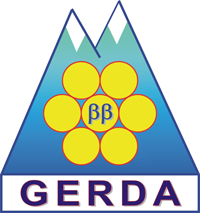
The GERDA experiment has been proposed in 2004 to be installed at LNGS and aims at the detection of the double-beta decay of 76Ge, an isotope of germanium.
Germanium is a solid semiconductor of very high purity (that is the content of natural radioactive elements like uranium, thorium, potassium, etc... is much lower than in other materials) widely used to build particle detectors of high sensitivity and precision. In the search for 76Ge double beta decay, germanium detectors, also referred as HPGe (High Purity Germanium detectors), are the ideal choice as they act at the same time as source and detector for this decay.
The double beta decay is a spontaneous process, already observed in some isotopes (76Ge, 100Mo, etc...), in which a 76Ge nucleus transforms into another nucleus (76Se) with the emission of two electrons and two antineutrinos. As the name (double beta decay) says, the net effect is that of two simple beta decays happening at the same time. [The beta decay is a spontaneous process in which an atomic nucleus transforms into a different nucleus emitting an electron and a neutrino (to be precise an antineutrino)].
Of great interest for physicists is a particular kind of double beta decay, called neutrinoless double beta decay, which happens with the emission of the electrons alone. This decay is theoretically expected but it has not yet been observed for a certainty. The Heidelberg-Moscow experiment at LNGS has detected in 2001 and confirmed during the following years, the existence of a signal which could be interpreted as a neutrinoless double beta decay of 76Ge. The final discovery of such a decay would be a most exciting event in the field of neutrino physics. The neutrino is a very elusive particle and some of its properties are not yet completely understood: the double beta decay would help us disclosing some of them. Moreover this discovery would have huge implications for cosmology, the science which studies the birth and the evolution of our Universe.
The double beta decay (with or without neutrinos) is a very rare process. The decay mode with neutrino production, which has been already observed for some isotopes, has measured characteristic times between 1019 and 1023 years, that is much more than the age of the Universe (1010 years). To increase the probability of detecting this decay, we need as much as possible 76Ge, that is the source of the decay. Naturally occurring germanium contains only 7.6% of 76Ge but it is possible to increase this percentage up to 86% with a procedure called enrichment. Even so, the probability to observe a neutrinoless double beta decay is extremely low. In a typical enriched germanium detector (about 2.5 kg) we expect less than one event per year.
It is also very important to avoid as much as possible the presence within the detectors of other particles or other processes like radioactive decays of different kind which can interfere with the measurements. For this reason all the experiments searching for double beta decay have to take place in underground laboratories, where the flux of cosmic particles is strongly reduced.
Because of their semiconducting properties, the HPGe detectors need to have a very low temperature, in order to work fine as particle detectors. Usually they are cooled down by using liquid nitrogen (nitrogen is a noble gas also present in air) which has a temperature of - 195°C. Recently, here at LNGS, the GENIUS-TF experiment has proved that germanium detectors can be operated directly in liquid nitrogen, immersed "naked" without the copper container where the detector is usually encapsulated.
In the GERDA experiment as well, the germanium detectors will be directly immersed in liquid nitrogen, contained in a copper pseudo-sphere of 2 meters diameter. This sphere will be inside a water tank of 3 meters diameter. The nitrogen acts at the same as a cooling medium and as a shield against the natural radioactivity of the environment and the radioactivity coming from the different materials of the setup, which can disturb the measurements. The water shield has the same function. Over the top of the experimental setup, a clean room will be built, with direct access to the inner nitrogen tank for the insertion of the detectors.
The first phase of the GERDA experiment foresees the use of several already existing enriched germanium detectors, for a total mass of 20 kg. In the following phases the mass of the detectors will be increased producing new detectors until a total mass of 500 kg will be reached, which is necessary to deeply investigate the existence of the neutrinoless double beta decay, the neutrino properties and the implications for cosmology and particle physics.
GERDA is an international collaboration between Italy, Germany, Russia and Poland.